#ane 144
Explore tagged Tumblr posts
Text


THE KIDS & THE ADULTS
Shura, honey, YOU HAVE TO SAY THAT??!! 😭😭😭😭😭
#blue exorcist#ao no exorcist#ao no exorcist manga#ane manga#blue exorcist manga#ane spoilers#ao no exorcist spoilers#blue exorcist spoilers#ane#ane 144#blue exorcist 144#ao no exorcist 144#rin okumura#yukio okumura#shiemi moriyama#izumo kamiki#konekomaru miwa#shima renzou#shura kirigakure#osceola redarm#cheng long liu#igor neuhaus#AH YES IT'S PAIN O'CLOCK
158 notes
·
View notes
Text
No regret
I love how Shura initially complaining about the possibility of impending death...

...led to the adults all admitting that the choice to stay and fight won't lead to any regret should they die...



...which allowed Shura to realize that she, too, has no regret.


Very emotional considering that, until fairly recently, Shura lived her life under a curse that condemned her to die at 30 years old.
Now though, the twins freed her from that curse and yet she might still die soon, but she has no regret. Because looking out for Shiro's kids, like he asked her, gave her purpose.


Character development, as always, is good! :D
That being said, I truly hope this chapter wasn't a death flag for her T_T
69 notes
·
View notes
Text

#so true!!!!!!!#cheng long liu#ao no exorcist#blue exorcist#aoex spoilers#ane spoilers#< tagging them both incase someone only has one of them blocked#ao no exorcist the movie#ao no exorcist chapter 144#im putting this in the main tags. sorry.#ane 144#ao no exorcist spoilers#just to be safe!!!
38 notes
·
View notes
Text
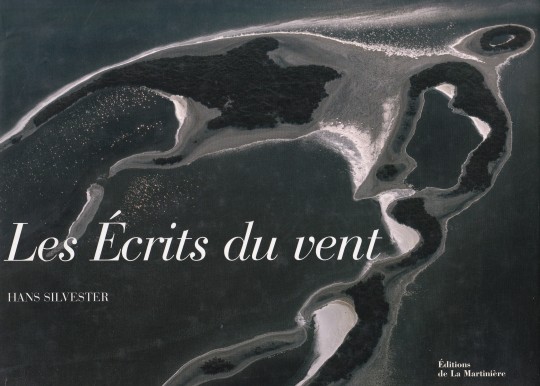

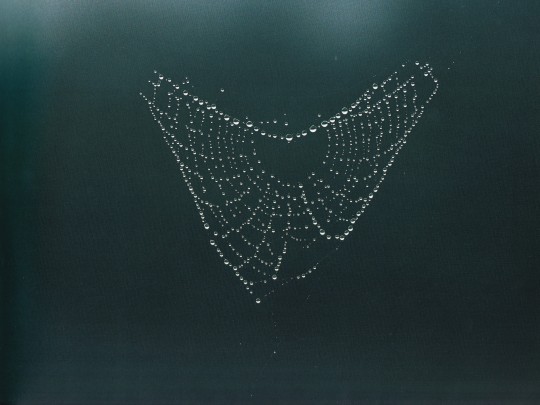






Les Écrits du du vent
Hans Silvester
Éditions de La Martinière, Paris 2003, 144 pages, 31x22,8cm, ISBN 978-2732429809
euro 20,00
email if you want to buy [email protected]
Les écrits du vent offrent pour qui sait les voir une nouvelle interprétation du monde. Au rythme des saisons, Hans Silvester a su saisir tout le mystère et la splendeur des paysages de Camargue, continuellement remodelés par le vent : ondoiement subtil à la surface d'un étang, infimes craquements terrestres, nuées d'oiseaux... autant d'images qui confondent notre perception de l'infiniment grand et de l'infiniment petit. Des textes issus de civilisations diverses accompagnent ces images surprenantes et explorent la poétique des éléments. En célébrant la beauté sauvage et le cycle éternel du monde, ils nous emmènent sur le chemin du rêve et de la méditation. Que nous révèlent et que nous enseignent ces paysages ? C'est à cette double et fascinante interrogation que veulent répondre Les Écrits du vent.
Né en 1938 en Allemagne, Hans Silvester fait ses premières photos à l'âge de douze ans. Défenseur inconditionnel de la nature, il publie en 1960 un livre remarqué sur la Camargue avec un texte de Jean Giono. Membre de l'agence Rapho, il a notamment publié aux Editions de La Martinière Les Chats du soleil, Les Chats du bonheur et Sieste et Tendresse, tous des succès internationaux. Les derniers reportages de ce grand voyageur l'ont mené en Inde, au Rajasthan, où il a photographié les peuples du désert de Thar et l'incroyable bestiaire des fresques du Shekhawati. Ce travail a donné lieu à deux livres, Les Filles de Mirabai et Les Cavaliers du Shekhawati. Son dernier ouvrage paru aux Éditions de La Martinière en 2002 s'intitule Chevaux de Camargue.
29/03/24
39 notes
·
View notes
Text

5 Stunden = 144 Drukos. Der größte Teil (nach den Vorlagen nicht überraschend) von deutschen Nichtdenkern. Die Frage, die interessanterweise gar nicht gestellt wird: Woher genau nimmt bitte Putin das Geld, mit dem er den Krieg führt?
Kaum zu fassen:

Es wird die Victoria hart treffen, aber trotz 11T Nachlaufenden ist sie auf Twitter nicht mehr relevant. Wer bei Twitter noch blockt, dem/der lege ich die Victoria zur Sicherheit trotzdem ans Herz.
Wirklich großartig "argumentiert" dieser Account:

Aber da hilft dann ein Blick ins Profil:

2 notes
·
View notes
Text





Avengers #144 “Claws!”
Written by Steve Englehart, Illustrated by George Perez ane Mike Esposito
4 notes
·
View notes
Text
on Coil's ANS (2004)
from “Out of Time, Out of Place, Out of Spite”: Light and Music of Coil and Skryabin by me
The ANS is believed to be one of the first electronic synthesizers in history. It was created in 1957 by a Moscow State University engineer Yevgeny Murzin. The optic disc of the machine contained 144 sounds that came to simultaneous resonance, producing spectral sounds rather than sound waves.[1] Among the composers who worked with the instrument are Alfred Schnittke, Sofia Gubaidulina, and Eduard Artemyev, a Russian composer famous for his extensive collaboration with Tarkovsky.[2] The son of Eduard Artemyev, Artemiy, describes the machine in a letter: “Please, try to imagine a score sounding by itself without a conductor, [without an] orchestra [and] even without musical instruments. This magic is possible by using [the] musical synthesizer ANS. The ANS is an instrument with which a composer cannot only create but even draw his music without notes and orchestra.”[3] The process of music creation here is described as writing with light in a miraculous process of drawing the music rather than playing it.

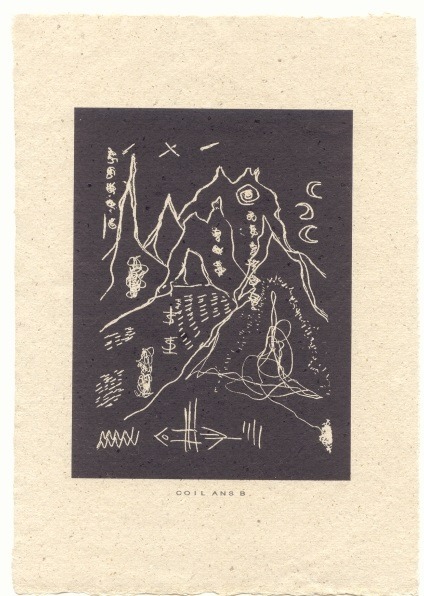
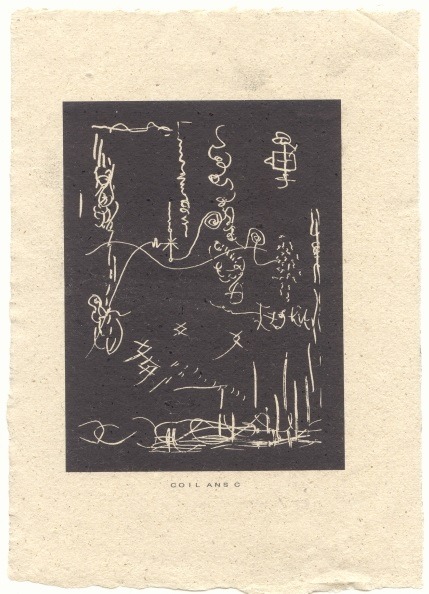
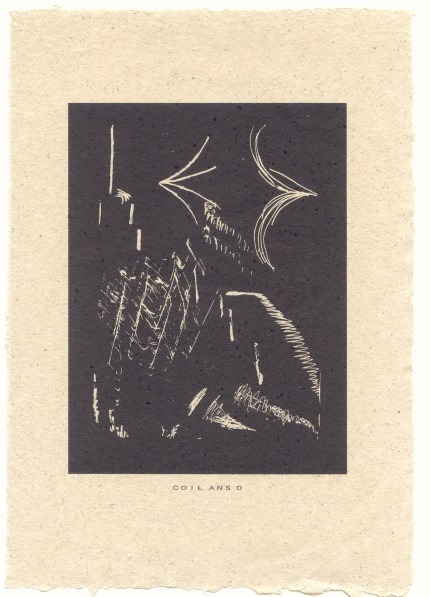
The Coil’s box set ANS, which was first published in September 2004 by Threshold House, is made entirely on the ANS machine. They were accompanied with limited edition prints that allow us to glimpse into the way visual “scores” that were fed into the ANS looked like. The sounds we hear on the box set are not necessarily composed, as they do not follow any particular musical pattern — only a visual pattern of a graphic card that went into the synthesizer. In this way, music on ANS is spectral in how the music is generated, as it does not necessitate the presence of a composer — by itself, it can translate figments of images into musical phantoms.
[1] Andrey Smirnov and Lyubov Pchelkina, “Russian Pioneers of Sound Art in the 1920s,” in Red Cavalry: Creation and Power in Soviet Russia between 1917 and 1945 (Madrid: La Casa Encendida, 2011), 12.
[2] Smirnov and Pchelkina, 13.
[3] Martin Alejandro Fumarola, “The Russian ANS Synthesizer, Another Early Electronic Instrument,” Computer Music Journal 21, no. 2 (1997): 4.
4 notes
·
View notes
Photo
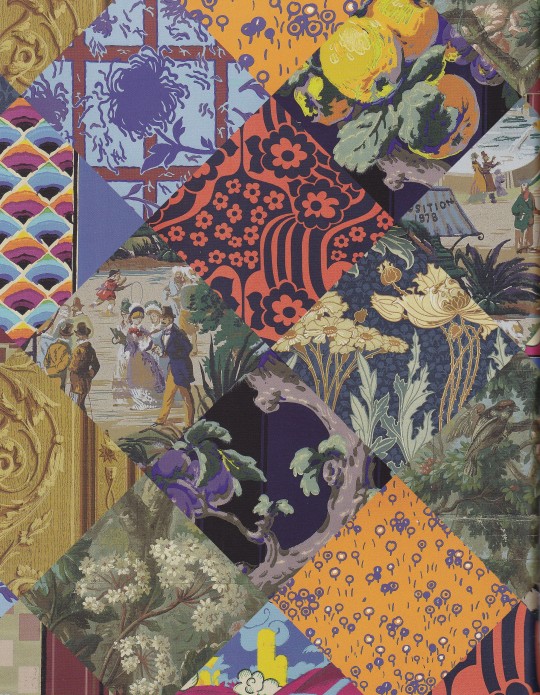
Décorer le monde Paris, Balagny-sur-Thérain, Milan
Essef Les papiers peints (1866-2006)
Christophe Leblan et Vincent Pruchnicki
Préface de Nadège Lefebvre
Archives départementales de l’Oise, Beauvais 2022, 144 pages, 246 ill. dont 231 en couleurs, 22 X 27,5 cm, broché, ISBN 978-2-86060-038-5
euro 32,00
email if you want to buy :[email protected]
Exposition du 18 septembre 2022 au 2 juin 2023
Cette publication vous présente de façon approfondie l’histoire de l’entreprise et propose un panorama des techniques utilisées et des goûts en matière de décoration d’intérieur depuis 140 ans.
Qu’ont en commun les maisons de George Sand, d’Emile Zola et de vos aïeux, qui soit haut en couleur, riche en fleurs et en formes géométriques ou peuplé d’animaux? Des murs tendus de papier peints aux raccords pas toujours parfaits! Mais comment en est-on venu à recouvrir ler murs de feuilles de papier? Quels sont les modes de fabrication du papier peint? Comment l’usage de ce décor s’est-il diffusé dans le monde entier? “Décorer le monde - Essef, les papiers peints (1966-2006)” vous apporte des réponses en suivant de Paris à Sydney, en passant par Milan, la brillante aventure d’une société oisienne de design mural.
27/01/23
orders to: [email protected]
ordini a: [email protected]
twitter: @fashionbooksmi
instagram: fashionbooksmilano, designbooksmilano tumblr: fashionbooksmilano, designbooksmilano
#Décorer le monde
#papier peint
#décoration d'intérieur
#catalogue exposition 2022
#Paris
#Balagny-sur-Thérain
#Milan
#Sydney
#design mural
#leonor fini
#Ruhlmann
#design books
#designbooksmilano
#fashionbooksmilano
4 notes
·
View notes
Text

Subject to Change Michael Corris, Stéphane Mroczkowski, Marjorie Welish, Alexandra Pignol Mare et Martin, le Kremlin-Bicêtre, France Collection Anatomies de la modernité (dir. Stéphane Mroczkowski, Alexandra Pignol)
Second semestre 2023, disponible novembre 2023 144 pages, bilingue anglais-français, offset couleur, format 23,5 x 20 cm, cartonné cousu, design Fred Dupuis, 39€
LE LIVRE :
Un poème de Bertolt Brecht, écrit durant la guerre 39-45, sert de point de départ à un livre de créations graphiques et de textes échangés entre quatre auteurs et artistes de Dallas, New York, Strasbourg.
Un livre qui expose le processus de création et de recherche, comme une enquête au sujet de la maison de Brecht à Santa Monica et de son importance comme lieu de création.
Sujet To Change est un ouvrage collaboratif mêlant dessins et textes, qui prend appui sur le poème de Bertolt Brecht « Le Masque du Méchant » (1942). Ce poème, écrit en exil, porte sur un masque de théâtre Nô qui devient l’image même du mal qui sévit alors en Europe. Ce poème nous conduit donc à prendre en compte différentes disciplines : histoire, littérature, poésie, théâtre.
À ce bref poème, chaque artiste-auteur répond dans un registre distinct et avec un style graphique et une écriture particuliers. Les nombreux dessins se répondent et dialoguent pour questionner la personne de Brecht, l’artiste, le poème, et les lieux de création artistique. L’essai d’Alexandra Pignol apporte, sur un ton libre, une somme essentielle d’informations et d’idées sur l’époque de Brecht en exil, à partir d’une ironie sur les idéaux de fonctionnalisme du Bauhaus.

THE BOOK :
A poem by Bertolt Brecht, written during the 1939-1945 war, is the starting point for a book of images and texts exchanged between artists and writers living in Dallas, New York and Strasbourg (France).
The work proposes to reveal and deconstruct the process of creation, research and exposition through an investigation of professional and domestic aspects of Brecht’s exile in the United States.
The collaborative work in Subject to Change begins with Bertolt Brecht’s poem, “The Mask of Evil” (1942). The central image of the poem is a Noh mask that Brecht had traveled with on his journey to the United States. In a sense, the mask functions as the epitome of absolute evil that existed in Europe during the Second World War, and leads us to consider different disciplines: history, literature, poetry, theater, and philosophy.
Each of the participants in the project responded to Brecht’s poem in a distinct register and style, engaging in a dialogue questioning Brecht: the poet, the work, the circumstances of creation, and the man. The essay by Alexandra Pignol provides additional information and insight this period in Brecht’s life, drawing a connection between Brecht’s poems written during his U.S. exile and his writings on the Bauhaus ideals of functionalism.
Subject to Change explores the relationship between seeing and reading, art and knowledge, form and content. The project aims to make the research process visible. The aim is not to reconstruct a historical journey or moment (Brecht in Santa Monica), nor to illustrate Brecht’s poem. Rather, the aim is to draw connections between the past and the present.





Subject to Change is available through Mare et Martin Publishers (Paris). To purchase a copy :
3 notes
·
View notes
Text

OLDER WOMAN 🤣🤣🤣🤣🤣🤣
#blue exorcist#ao no exorcist#ao no exorcist manga#ane manga#blue exorcist manga#ane spoilers#ao no exorcist spoilers#blue exorcist spoilers#ane#blue exorcist 144#ao no exorcist 144#ane 144#rin okumura#yukio okumura#shiemi moriyama#izumo kamiki#ryuji suguro#konekomaru miwa#shima renzou#CRYING BUT WHEEZE#🤣🤣🤣🤣
105 notes
·
View notes
Text
Le Chiffre de GEO : deux fois moins de pollinisateurs dans les prairies agricoles traitées aux engrais
See on Scoop.it - Les Colocs du jardin
Sur le plus ancien terrain expérimental du monde, des chercheurs britanniques ont montré que l'engrais diminuait de moitié l'abondance des pollinisateurs et réduisait leur diversité dans les prairies agricoles. Ces apports favoriseraient les herbes à croissance rapide au détriment des fleurs (The Guardian).
Nastasia Michaels Publié le 21/01/2025 à 13h02
L'effet des engrais sur les insectes pollinisateurs en chiffres :
Durée de l'expérience : 2 ans, sur un terrain expérimental créé il y a près de 150 ans (celui de Park Grass, à Rothamstead, à 50 km au nord de Londres)
Surface expérimentale : 56 640 mètres carrés (1 416 x 40 m2)
Nombre de butineurs comptés : 1285, dont des abeilles et bourdons (65,8 %), des mouches (27,5 %), des coléoptères (2,9 %), des papillons (2,1 %) et des guêpes (1,6 %)
Abondance et diversité des fleurs : respectivement 5 fois et 8 fois plus importantes dans les parcelles non traitées que dans celles recevant la plus grande quantité d'engrais (144 kg par hectare, la moyenne nationale étant de 100 kg/ha)
Abondance et diversité des pollinisateurs : hausse respective de 95 % et de 84 % dans les parcelles non traitées par rapport à celles recevant des niveaux élevés d'engrais.
0 notes
Text
Au 31 décembre 2024, le nombre de demandeurs-euses d'emploi augmente de 286 par rapport au moins précédent, pour atteindre 5'949 personnes. Une hausse du nombre de chômeurs-euses (+144) est également observée avec un effectif se fixant désormais à 3'745 personnes. Cette augmentation, habituelle au mois de décembre, est liée en partie aux facteurs saisonniers défavorables qui touchent principalement le secteur de la construction en cette période hivernale. Si le taux de chômage neuchâtelois augmente de 0.1 pt au mois de décembre 2024 pour atteindre 4.2 %, la hausse est plus marquée au niveau national (+0.2 pt) ainsi qu'au niveau de la Suisse romande (+0.3 pt), avec des taux s'établissant respectivement à 2.8 % et 4.1 %. En variation annuelle, le taux de chômage cantonal augmente de 1.1 pt entre les mois de décembre 2023 et 2024. Au niveau national, sur la même période, le taux de chômage augmente de 0.5 pt. Alors qu'en 2023 le taux de chômage neuchâtelois avait atteint des niveaux historiquement bas, une hausse progressive a été relevée durant l'année 2024. Le taux de chômage s'élève en moyenne annuelle à 3.6 % (alors qu'il s'élevait à 2.7 % en 2023, 3.0 % en 2022 et 4.4 % en 2021). Les variations mensuelles du nombre de chômeurs-euses dans le canton recouvrent une évolution contrastée selon les différentes catégories d'âge. En effet, les jeunes de moins de 25 ans (-3) voient leur effectif diminuer légèrement par rapport au mois de novembre. Au contraire, les personnes âgées de 25 à 49 ans (+105) ainsi que les plus de 50 ans (+42) voient leur effectif augmenter. Ainsi, le taux de chômage des jeunes (moins de 25 ans) demeure stable à 4.9 % et le taux de chômage des seniors augmente de 0.2 pt pour atteindre 3.6 %. En ce qui concerne les secteurs économiques, une augmentation importante du nombre de chômeurs-euses est constatée pour le secteur saisonnier de la construction (+93). Une hausse est également relevée dans le secteur de l'horlogerie (+21), des autres activités manufacturières (+11) et du commerce de gros et réparations d'autos et motos (+11). Situation à Val-de-Travers Taux de chômage: 3,6% Chômeurs: 200 Demandeurs d'emploi: 330
0 notes
Text
Class 5 math EV chapter 5 creative questions with ans

Class 5 math EV chapter 5 creative questions with ans
Question 01 Four bells rang at once in the beginning and then rang after every 5, 7, 12, 15 seconds. (a) What is the LCM of the time of ringing of first two bells (b) What is general price factor of time of ringing of 3rd and 4th bell? (c) Which smallest number can be divided by the ringing times of the bells without remainder? (d) After what minimum time the bells will ring together again? Solution: (a) 5 = 1x5 and 7 =1 x 7 LCM of 5 and 7 is = 1 x 5 x 7 = 35 (b) 12=2x2x3 and 15=3 x 5 The common prime factor of 12 and 15 is 3 (c) The LCM of the ringing times is required smallest number 3) 5, 7, 12, 15 5) 5, 7, 4, 5 1, 7, 4, 1 LCM of the numbers = 3 x 5 x 7 x 4 = 420 Required smallest number is 420 (d) The LCM of 5, 7, 12, 15 is the required minimum time The minimum time is 420 sec and = minute = 7 minute After 7 minutes the bell will ring together again Question 02 In a class the teacher told the students to write the smallest number of 4 digits and biggest number of 3 digits, whose digit of ones place will be 8. (a) Write the 2 numbers (b) What is the sum and differences of the two numbers? (c) Write the prime factors of the biggest number. (d) What is the LCM of the numbers? (e) What is the GCF of the numbers? Solution: (a) Smallest number of four digits whose digit in the ones place is 8 is = 1008 And, biggest number of three digits whose digit in the ones place is 8 is = 998 (b) Sum of the numbers = (1008 + 998) = 2006 Difference of the numbers = (1008 – 998) = 10 (c) Biggest number is 1008 1008 = 2 x 2 x 2 x 2 x 3 x 3 x 7 The prime factors of 1008 are 2,2,2,2,3,3,7 (d) 998 = 2x499 Prime factors of 998 are 2, 499 The common prime factors of 998 and 1008 is 2 GCF of 1008 and 998 is 2 (e) LCM of 1008 and 998 is =2 x 2 x 2 x 2 x 3 x 3 x 7 x 499 =16 x 9 x 7 x 499 = 502992 LCM of 1008 and 998 is 502992 Creative math questions and solutions for Class 5 EV Chapter 5 to make learning easier and more fun. Question 03 Three values are given, 24, 48, 72. (a) Write down 2 multiples of 24, 48, 72 (b) Write down the common multiples of 24 and 72 (c) Find the L.C.M of 24, 72 (d) Find the L.C.M of 24, 48, 72. Ans. (a) 2 multiples of 24 are = 48, 72 2 multiples of 48 are = 96, 144 2 multiples of 72 are = 144, 216 (b) Multiples of 24 are = 48, 72, 96, 120, 144, 168, 192, 216, 240, 264, 288 Multiples of 72 are = 144, 216, 288, 360, 432 Common multiples of 24 and 72 are = 144, 216, 288, ….. (c) 2)24, 72 2)12, 36 2)6, 18 3)3, 9 1, 3 L.C.M of 24, 72 is = 2 x 2 x 2 x3 x 1 x 3 = 72 (d) 2)24, 48, 72 2)12, 24, 36 2)6, 12, 18 3) 3, 6, 9 1, 2, 3 L.C.M of 24, 48, 72 is = 2 x 2 x 2 x 3 x 2 x 3 x 1 = 144 Question 04 Mr. Amzad brought about 40 mangoes, 85 apples from the market. He distributed the fruits equally. The price of 4 mangoes is 40 taka. (a) What is the price of mangoes? (b) If per piece cost 5 taka how much price will the apples be? (c) He distributed the fruits how many members? (d) Each person gave how many fruit? Answer: (a) The price of 4 piece of mango is 40 taka The price of 1 piece of mango is (40÷4) = 10 taka The price of 40 pieces of mango is (40x10) = 400 taka (b) 1 piece apples cost 5 taka 85 pieces of apples cost (5x85) = 425 taka (c) 40 = 2 x 20 = 2 x 2 x 10 = 2 x 2 x 2 x 5 85 = 5 x17 GCF = 5 He distributed the fruits among 5 person. (d) Each person gave (40 ÷ 5) = 8 piece mango Each person gave (85 ÷ 5) 17 piece apple Easy and fun questions with answers for Class 5 EV Chapter 5 to help students improve their math skills. Question 05 A number of saplings is such that when 3, 5, 6, 8, 10 or 15 are planted in each row, every time two saplings are left out. (a) What is the GCF of last 3 numbers? (b) What is the LCM of the given numbers? (c) what is the minimum number of saplings? (d) If we plant 18 saplings in 16 rows then how many more saplings do we need? Solution: (a) 8 = 1 x 2 x 2 x 2 10 = 1 x 2 x 5 15 = 1 x 3 x 5 GCD of 8, 10 and 15 is =1 (b) 2) 3, 5, 6, 8, 10, 15 3) 3, 5, 2, 4, 5, 15 1, 5, 1, 4, 1, 5 LCM = 2 x 3 x 5 x 4 = 120 (c) The minimum number of sampling is = (120 + 2) =122 (d) Number of extra saplings ={(16 x 8) – 122} =(128 – 122) = 6 Question 06 Tushi set a few no. of bell in their drawing room. After ringing together they rand after every 6, 9, 12, 15 seconds respectively. (a) Find the GCF (b) Find the LCM (c) What is the summation of 4 multiples of 9? (d) When the bells will ring together again? Ans. (a) 6 = 2 x 3 9 = 3 x 3 12 = 2 x 2 x 3 15 = 3 x 5 GCF of 6, 9, 12, 15 is = 3 (b) 3) 6, 9, 12, 15 2) 2, 3, 4, 5 1, 3, 2, 5 LCM of 6, 9, 12, 15 = 3 x 2 x 3 x 2 x 5 x 1 = 180 (c) 4 multiples of 9 are = 9, 18, 27, 36. Sum of 4 multiples of 9 is = 9 + 18 + 27 + 36=90 (d) 3)6, 9, 12, 15 2)1, 3, 2, 5 1, 3, 2, 5 LCM = 3 x 2 x 3 x 2 x 5 x 1=180 The bells of the drawing room will ring again together after 10 seconds. Question 07 16, 24, 2 and 40 are four even numbers. (a) Write the factors of first 2 numbers (b) Write 2 multiples of last wo numbers. (c) Which smallest number when divided by the four number gives 6 as remainder? (d) Find the next number after 4 & 6 which can be divided by 32 without any remainder. Solution: (a) Factors of 16 are = 1, 2, 4, 8, 16 Factors of 24 are = 1, 2, 3, 4, 8, 12, 24 (b) 32 x 1 = 32 32 x 2= 64 The multiples of 32 are 32, 64 and 40 x 2 = 80 (c) The multiples of 40 are 40, 80. 2) 16, 24, 32, 40 2) 8, 12, 16, 20 2) 4, 6, 8, 10 2) 2, 3, 4, 5 1, 3, 2, 5 LCM of 16, 24, 32, 40 is = 2x2x2x3x2x5 = 480 Required smallest number = (480 + 6) = 486 (d) Required number = (486 + 32) -6 = 518 – 6 = 512 Question 08 210 mangoes and lychees are divided among some boys and girls. If the number of mangoes is 60 then. (a) What is the number of lychees? (b) Write the number of mangoes and lychees in prime factors. (c) Among how many maximum number of boys and girls the fruits can be divided equally so that no fruit is left? (d) How many fruits will each one get? (e) How many mangoes and how many lychees will each get? Solution: (a) Number of lychees = (210-60) = 150 (b) Number of mangoes and lychees are 60 and 150 60 = 2 x 2 x 3 x 5 150 = 2 x 3 x 5 x 5 (c) If we divide 60 mangoes and 150 lychees among boys and girls with no fruit being left, then GDS of 60 and 150 is the required maximum number of boys and girls. The common prime factors of 60 and 150 are = 2,3 and 5 Required maximum number of boys and girls is 30 (d) Number of fruits each one will get is = (210 ÷ 30) =7 (e) Number of mangoes each one will get is = (60 ÷ 30)= 2 Number of lychees each one will get is = (150 ÷ 30) = 5 Master Class 5 Math EV Chapter 5 with creative questions and simple answers for better learning. Question 09 The length and breath of a rectangular house is 7.20 meters and 44 decimeters. The floor of the house has to be fitted with marbles so that no marble has to be broken. (a) Express the length of the house in decimeter (b) What is the area of the house in square decimeter? (c) Express the length and breath of the house in prime factors. (d) What is the maximum size of the marble stone needed? (e) How many marble stones are needed for the floor? Solution: (a) Length of the house = (7.20 x 10) decimeter = 72 decimeters (b) Area of the rectangular house =(length x breath) =(72 x 44) square decimeters = 3168 square decimeters (c) Length of the house is 72 decimeters and breath is 44 decimeters. 72 = 8 x 9 = 2 x 2 x 2 x 3 x 3 44 = 2 x 22 = 2 x 2 x 11 (d) The length of the required marble will be equal to the GCF of 72 and 44. GCF of 72 and 44 = 2 x 2 = 4 The maximum length of the required marble stone is 4 decimeters. (e) Are of the square marble stones is =(4 x 4) square decimeters = 16 square decimeters Numbers of marble stones needed for the floor is (3168 ÷ 16) = 198 Question 10 The capacity of holding water for 2 drums are 228 liters and 348 liters. (a) Express the capacity of first drum in prime factors. (b) What are the common prime factors of the capacity of 1st and 2nnd drum? (c) What will be the maximum capacity of a pitcher with which we can fill the drums by pouring water integer numbers of times? (d) How many pitcher of water each drum can hold? (e)How many pitcher of water is totally needed to fill 2 drums? Solution: (a) Water holding capacity of the 1st drum is 228 liter. 228= 2 x 2 x 3 x 19 (b) Water holding capacity of the 2nd drum is 348 liters. 348 = 2 x 2 x 3 x29 The common factors of 228 and 348 are 2, 2,3 (c) The GCF of the capacities of the two drums is the required maximum capacity of the pitcher. GCF of 228 and 348 is = 2 x 2 x 3 = 12 The maximum water holding capacity of the pitcher is 12 liters. (d) Amount of water needed to fill the first drum = (228 ÷ 12) pitchers = 19 pitchers Amount of water needed to fill the 2nd drum = (348 ÷ 12) pitchers = 29 pitchers (e) To fill the two drums total amount of water needed is = (29 + 19) pitchers = 48 pitchers More Questions: Q-11 Three bells having tolled together began to toll after every 9, 12 and 15 minutes. (a) What is done to find out after what minimum time will the bells toll together again? (b) After what time will the bells toll together again? (c) If the bells began tolling after every 6, 9 and 12 minutes, after what minimum times will the bells toll together again? Q-12
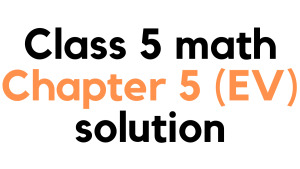
100 mangoes and 180 leychees are divided among some children. (a) What is the largest number of children among whom mangoes and lychees are divided without any reminder? (b) How many mangoes will each of them get? (c) How many lychees will each of them get? Q-13 There are 126 mangoes, 231 lychees and 357 jackfruit sapling are distributed for planting a village. (a) What is the largest number of villagers among whom sapling can be divided equally? (b) How many mangoes, how many lychees and how many jackfruit will each of them get? Q-14 There are two bells. One bell rings after each 12 minutes and the other bell rings after 5 minutes. (a) What is the L.C.M of the numbers representing ringing time of the two bells? (b) If a bell ringing after every 7 minutes is included with the given two bells, then the 3 bells will ring altogether. after how long time they once ring together? (c) If the two bells ring together at 3 p.m, then when will they ring again altogether? Q-15 There are two drums of capacity to contain water of 228 litres and 348 litres. (a) What is the G.C.F. of 228 and 348? (b) How many pitchers of water of the highest capacity will be required to fill both the drums separately? (c) What is the least number exactly divisible by 228 and 348? Q-16 The length and the breadth of a hall room of rectangular size are 12 metre and 7 metre respectively. (a) What is the biggest square size tile that can be used to cover the hall room without breaking any of them. (b) If the length of the hallroom is increased by 3 metre and the breadth is decreased by 2 metre, what will be the change of area of the hallroom? Q-17 12, 18, 24 and 30 are four even numbers with 2 digits. (a) Find out the first 4 multiple of 12. (b) Find out the LCM of the given numbers. (c) What is the greatest common number among the given numbers? Explore creative and easy math questions with answers for Class 5 EV Chapter 5 to help students learn effortlessly. Q-18 Four bells rang at the same time and then rang again at an interval of 5, 7, 12 and 15 seconds respectively. (a) What is a prime number? (b) Write the 1st 4 multiples of 15. (c) After what interval of time will the bell ring again together? (d) What is the G.C.F. of 5, 7, 12 and 15? Q-19 147 lichees were distributed among some boys and it was found that each boy got 11 lichees and 4 lichees were in excess. (a) Express the above information mathematically in the form of an open sentence? (b) Find out the number of boys among whom the lichees were distributed. (c) If of the liches are distributed among some boys and each boy gets 11 lichees leaving 5 as excess, express the above information in an open sentence. Q-20 A particular numbers is multiplied by and then the product is divided by 6 to get 21 as quotient. (a) Write the open sentence with the help of the information given above. (b) What is the value of the particular number according to the open sentence in (a)? (c) If 3 times x equals 3 more than 45, what is the value of x? Read the full article
0 notes
Text
Benjamin GUÉRIN, Quand nous étions des loups (poèmes), estampes de Robert Lobet, Editions de Corlevour, septembre 2024, 144 pages, 18 €
Une chronique de Marc Wetzel Benjamin GUÉRIN, Quand nous étions des loups (poèmes), estampes de Robert Lobet, Editions de Corlevour, septembre 2024, 144 pages, 18 € Ce poète de 40 ans vit en lisière de l’Aubrac, potier au pays de Peyre, et nous raconte d’abord les deux brebis récemment prélevées, dans son paisible jardin – là même où le jour ses enfants “vont et viennent” ! – en bordure de…

View On WordPress
#144 pages#18 €#Benjamin GUÉRIN#Editions de Corlevour#estampes de Robert Lobet#Marc Wetzel#Quand nous étions des loups (poèmes)#septembre 2024
0 notes
Text
Tenths and Hundredths Class 5 JKBOSE Solutions
“Tenths and Hundredths” is Chapter 9 from Merry Math V for students of Class 5th of JKBOSE. This post is about Tenths and Hundredths Class 5 JKBOSE Solutions. You read about Boxes and Sketches Class 5 JKBOSE Solutions in a previous post. Let’s get started: Tenths and Hundredths Class 5 JKBOSE Solutions Page No. 144 Solutions What was the length of the smallest pencil you have used? Ans. The…

View On WordPress
0 notes
Text
Thailande KOH SAMUI - Naya Natura Villas NEW - Sunfim
KOH SAMUI - Naya Natura Villas NEW Thailande Référence : 3828 Ć partir de 144 000 ā‚¬ Précédent Suivant Description 2 et 3 chambresTerrain de 408 m² à 637 m²Projet sur planÉlectricité publiqueBail emphytéotique de 30 ans Nos villas de style balinais sont conçues pour offrir une harmonie parfaite...
0 notes